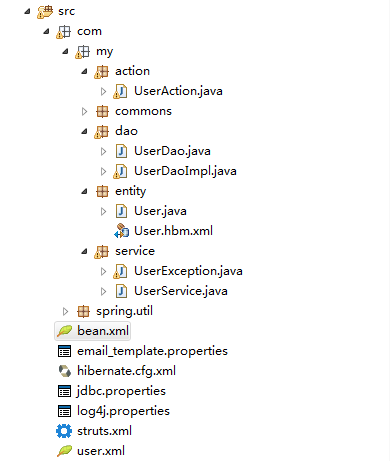搭建ssh框架相关配置文件总结
第一步 导入jar包
第二步 搭建struts2环境
(1)创建action(继承actionnsuport),创建struts.xml配置文件,配置action
|
1
|
public
class
UserAction
extends
ActionSupport{}
|
|
1
2
3
4
5
6
7
8
9
10
11
|
<?xml version=
"1.0"
encoding=
"UTF-8"
?>
<!DOCTYPE struts PUBLIC
"-//Apache Software Foundation//DTD Struts Configuration 2.3//EN"
"http://struts.apache.org/dtds/struts-2.3.dtd"
>
<struts>
<
package
name=
"User_test"
extends
=
"struts-default"
namespace=
"/"
>
<action name=
"user_*"
class
=
"com.my.action.UserAction"
method=
"{1}"
>
</action>
</
package
>
</struts>
|
(2)配置struts2的过滤器,在web.xml中
|
1
2
3
4
5
6
7
8
|
<filter>
<filter-name>struts2</filter-name>
<filter-
class
>org.apache.struts2.dispatcher.ng.filter.StrutsPrepareAndExecuteFilter</filter-
class
>
</filter>
<filter-mapping>
<filter-name>struts2</filter-name>
<url-pattern>/*</url-pattern>
</filter-mapping>
|
第三步 搭建hibernate环境
(1)创建实体类,User
|
1
2
3
4
5
6
7
8
9
10
|
public
class
User {
private
Integer uid;
private
String username;
private
String password;
private
String email;
private
String code;
private
Boolean state;
//再生成set/get方法
}
|
实体类编写规则
| 1 实体类里面属性私有的
2 私有属性使用公开的set和get方法操作
3 要求实体类有属性作为唯一值(一般使用id值)
4 实体类属性建议不使用基本数据类型,使用基本数据类型对应的包装类 (1)八个基本数据类型对应的包装类 - int – Integer - char—Character、 - 其他的都是首字母大写 比如 double – Double (2)比如 表示学生的分数,假如 int score; - 比如学生得了0分 ,int score = 0; - 如果表示学生没有参加考试,int score = 0;不能准确表示学生是否参加考试 l 解决:使用包装类可以了, Integer score = 0,表示学生得了0分, l 表示学生没有参加考试,Integer score = null; |
(2)配置实体类和数据库表映射关系,User.hbm.xml
|
1
2
3
4
5
6
7
8
9
10
11
12
13
14
15
16
|
<?xml version=
"1.0"
encoding=
"UTF-8"
?>
<!DOCTYPE hibernate-mapping PUBLIC
"-//Hibernate/Hibernate Mapping DTD 3.0//EN"
"http://www.hibernate.org/dtd/hibernate-mapping-3.0.dtd"
>
<hibernate-mapping>
<
class
name=
"com.my.entity.User"
table=
"t_user"
>
<id name=
"uid"
column=
"uid"
>
<generator
class
=
"native"
></generator>
</id>
<property name=
"username"
column=
"username"
></property>
<property name=
"password"
column=
"password"
></property>
<property name=
"email"
column=
"email"
></property>
<property name=
"code"
column=
"code"
></property>
<property name=
"state"
column=
"state"
></property>
</
class
>
</hibernate-mapping>
|
(3)创建hibernate核心配置文件,hibernate.cfg.xml
- 引入映射配置文件
(配置文件需要引入约束)
|
1
2
3
4
5
6
7
8
9
10
11
12
13
14
15
|
<?xml version=
"1.0"
encoding=
"UTF-8"
?>
<!DOCTYPE hibernate-configuration PUBLIC
"-//Hibernate/Hibernate Configuration DTD 3.0//EN"
"http://www.hibernate.org/dtd/hibernate-configuration-3.0.dtd"
>
<hibernate-configuration>
<session-factory>
<!-- 这里没有配置数据库,之后创建spring的时候配置 -->
<property name=
"hibernate.show_sql"
>
true
</property>
<property name=
"hibernate.format_sql"
>
true
</property>
<property name=
"hibernate.hbm2ddl.auto"
>update</property>
<property name=
"hibernate.dialect"
>org.hibernate.dialect.MySQLDialect</property>
<mapping resource=
"com/my/entity/User.hbm.xml"
/>
</session-factory>
</hibernate-configuration>
|
第四步 搭建spring环境
(1)创建spring核心配置文件
|
1
2
3
4
5
6
7
8
9
10
11
12
13
14
15
16
17
|
<?xml version=
"1.0"
encoding=
"UTF-8"
?>
<beans xmlns=
"http://www.springframework.org/schema/beans"
<!-- IOC相关 -->
xmlns:xsi=
"http://www.w3.org/2001/XMLSchema-instance"
<!-- IOC相关 -->
xmlns:p=
"http://www.springframework.org/schema/p"
<!-- P名称空间 -->
xmlns:context=
"http://www.springframework.org/schema/context"
<!-- IOC注解相关 -->
xmlns:aop=
"http://www.springframework.org/schema/aop"
<!-- aop相关 -->
xmlns:tx=
"http://www.springframework.org/schema/tx"
<!-- 事务相关 -->
xsi:schemaLocation="http:
//www.springframework.org/schema/beans
http:
//www.springframework.org/schema/beans/spring-beans.xsd
http:
//www.springframework.org/schema/context
http:
//www.springframework.org/schema/context/spring-context.xsd
http:
//www.springframework.org/schema/aop
http:
//www.springframework.org/schema/aop/spring-aop.xsd
http:
//www.springframework.org/schema/tx
http:
//www.springframework.org/schema/tx/spring-tx.xsd">
</beans>
|
(2)让spring配置文件在服务器启动时候加载,在web.xml中
- 配置监听器
- 指定spring配置文件位置
|
1
2
3
4
5
6
7
8
9
10
|
<context-param>
<param-name>contextConfigLocation</param-name>
<param-value>classpath:bean.xml</param-value>
</context-param>
......
<listener>
<listener-
class
>org.springframework.web.context.ContextLoaderListener</listener-
class
>
</listener>
|
第五步 struts2和spring整合
(1)把action在spring配置(action多实例的)
(2)在struts.xml中action标签class属性里面写 bean的id值
|
1
2
3
|
bean.xml
<bean id=
"userAction"
class
=
"com.my.action.UserAction"
scope=
"prototype"
>
</bean>
|
|
1
2
|
struts.xml
<action name=
"user_*"
class
=
"userAction"
method=
"{1}"
>
|
第六步 spring和hibernate整合
(1)把hibernate核心配置文件中数据库配置,在spring里面配置
(2)把hibernate的sessionFactory在spring配置
|
1
2
3
4
5
6
7
8
9
10
11
12
13
14
15
16
|
<bean id=
"dataSource"
class
=
"com.mchange.v2.c3p0.ComboPooledDataSource"
>
<property name=
"driverClass"
value=
"com.mysql.jdbc.Driver"
></property>
<property name=
"jdbcUrl"
value=
"jdbc:mysql:///my"
></property>
<property name=
"user"
value=
"root"
></property>
<property name=
"password"
value=
"123"
></property>
</bean>
<bean id=
"sessionFactory"
class
=
"org.springframework.orm.hibernate5.LocalSessionFactoryBean"
>
<property name=
"dataSource"
ref=
"dataSource"
></property>
<property name=
"configLocations"
value=
"classpath:hibernate.cfg.xml"
></property>
</bean>
<bean id=
"transactionManager"
class
=
"org.springframework.orm.hibernate5.HibernateTransactionManager"
>
<property name=
"sessionFactory"
ref=
"sessionFactory"
></property>
</bean>
<tx:annotation-driven transaction-manager=
"transactionManager"
/>
|
第七步 完成互相注入关系(在dao里面使用hibernateTemplate)
(1)在dao注入hibernateTemplate对象
(2)在hibernateTemplate对象中注入sessionFactory
|
1
2
3
4
5
6
|
public
class
UserAction
extends
ActionSupport{
private
UserService userService;
public
void
setUserService(UserService userService) {
this
.userService = userService;
}
}
|
|
1
2
3
4
5
6
7
8
9
10
11
12
13
14
15
16
17
18
19
20
|
@Transactional
public
class
UserService {
private
UserDao userDao;
public
void
setUserDao(UserDao userDao) {
this
.userDao = userDao;
}
}
/**
问题:如果在service类上面没有添加注解,出现异常
问题:只读模式下(FlushMode.NEVER/MANUAL)写操作不被允许:把你的Session改成FlushMode.COMMIT/AUTO或者清除事务定义中的readOnly标记。
错误原因:
OpenSessionInViewFilter在getSession的时候,会把获取回来的session的flush mode 设为FlushMode.NEVER。
然后把该sessionFactory绑定到TransactionSynchronizationManager,使request的整个过程都使用同一个session,在请求过后再接除该sessionFactory的绑定,
最后closeSessionIfNecessary根据该session是否已和transaction绑定来决定是否关闭session。
在这个过程中,若HibernateTemplate 发现自当前session有不是readOnly的transaction,就会获取到FlushMode.AUTO Session,使方法拥有写权限。
也即是,如果有不是readOnly的transaction就可以由Flush.NEVER转为Flush.AUTO,拥有insert,update,delete操作权限,如果没有transaction,并且没有另外人为地设flush model的话,则doFilter的整个过程都是Flush.NEVER。
所以受transaction(声明式的事务)保护的方法有写权限,没受保护的则没有。
*/
|
|
1
|
public
interface
UserDao {}
|
|
1
|
public
class
UserDaoImpl
extends
HibernateDaoSupport
implements
UserDao {}
|
|
1
2
3
4
5
6
7
8
9
10
11
12
13
14
|
<bean id=
"userAction"
class
=
"com.my.action.UserAction"
scope=
"prototype"
>
<property name=
"userService"
ref=
"userService"
></property>
</bean>
<bean id=
"userService"
class
=
"com.my.service.UserService"
>
<property name=
"userDao"
ref=
"userDaoImpl"
></property>
</bean>
<bean id=
"userDaoImpl"
class
=
"com.my.dao.UserDaoImpl"
>
<property name=
"sessionFactory"
ref=
"sessionFactory"
></property>
</bean>
<!--
这一部分可以另外创建一个xml文件(比如user.xml),再引入bean.xml中的约束,
最后在bean.xml中引入这个文件<
import
resource=
"classpath:user.xml"
/>
适合多人开发。
-->
|
最后结构图:
测试:启动服务器(我试过tomcat和resin),如果没有报错,并且数据库中存在数据表,则说明成功。
注意:数据库必须有,表可以没有;log4j.properties是一个可以显示详细日志信息的配置文件。
补:
在web.xml中在配置如下,原因是防止"no session"问题
|
1
2
3
4
5
6
7
8
9
|
<filter>
<filter-name>openSessionInViewFilter</filter-name>
<filter-
class
>org.springframework.orm.hibernate5.support.OpenSessionInViewFilter</filter-
class
>
</filter>
<filter-mapping>
<filter-name>openSessionInViewFilter</filter-name>
<url-pattern>/*</url-pattern>
</filter-mapping>
|
